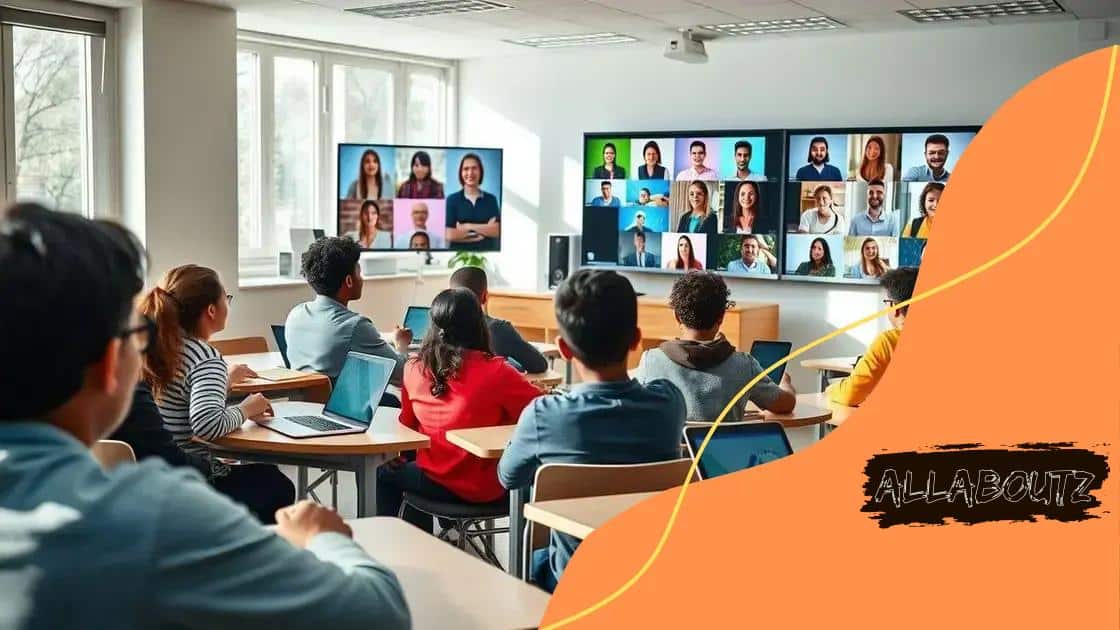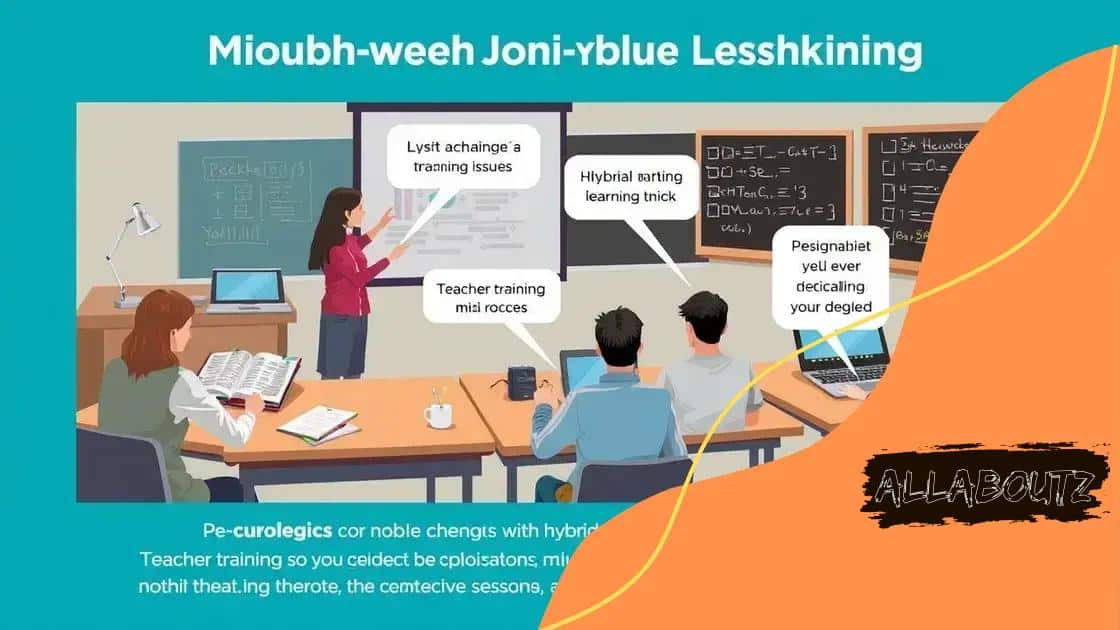Hybrid learning models for schools and universities

Hybrid learning models for schools and universities blend traditional and online teaching methods, enhancing flexibility, engagement, and personalized learning experiences while addressing challenges such as technology access and teacher training.
Hybrid learning models for schools and universities are reshaping the educational landscape, blending traditional teaching with online resources. Have you considered how these models can enhance learning experiences and optimize engagement?
Understanding hybrid learning models
Understanding hybrid learning models is essential for modern education. These models combine traditional classroom teaching with online learning, creating a flexible environment. Students benefit from various learning styles while teachers adapt their strategies to improve engagement.
Key Features of Hybrid Learning Models
In a hybrid learning setup, both in-person and online components are essential. This approach allows schools to reach more students while accommodating diverse needs. Below are some key features:
- Flexibility: Students choose how they learn best.
- Accessibility: Online resources extend learning beyond the classroom.
- Personalization: Education can be tailored to individual strengths and challenges.
Teachers play a critical role in this model. They facilitate interactions and ensure that all students participate. With technology, classrooms become more interactive, allowing students to engage in discussions even when they are not physically present. Imagine students contributing ideas via digital platforms, enriching the learning experience.
The Role of Technology
Technology greatly enhances hybrid learning. Software platforms enable seamless communication and collaboration between students and teachers. This digital environment supports various educational tools, such as:
- Video conferencing for real-time discussions.
- Online quizzes to reinforce learning.
- Collaborative projects using shared documents.
Such tools foster engagement, enabling students to interact with their peers. Importantly, as technology evolves, so do the methods educators use to engage students effectively. As the world embraces digital advancements, schools must adapt to modernize education practices.
Benefits of hybrid education for students
Benefits of hybrid education for students are becoming clearer as more institutions adopt this model. Students experience a unique blend of in-person and online lessons, making learning more flexible and accessible. This approach tailors education to fit individual needs, allowing students to thrive.
Enhanced Flexibility
One of the main advantages is the increased flexibility in learning schedules. Students can access materials online at their convenience, balancing their studies with personal obligations. This flexibility often leads to better time management and reduced stress.
- Students can learn at their own pace.
- Access to resources anytime, anywhere.
- Ability to balance school with extracurricular activities.
Additionally, hybrid education encourages students to take ownership of their learning. They can choose when and how they engage with the material, which fosters independence and self-discipline. This empowerment can lead to higher motivation and engagement levels.
Diverse Learning Opportunities
Hybrid education provides students with diverse learning opportunities. The combination of online and classroom experiences fosters various interaction styles. Some students excel in online discussions, while others thrive during face-to-face interactions. This diversity makes learning more inclusive.
- Exposure to various teaching methods.
- Collaboration with peers in different formats.
- Access to a wider range of resources and technologies.
Students gain valuable skills that prepare them for future workplaces, which increasingly rely on digital communication and collaboration. The experience enhances critical thinking and adaptability, qualities essential in today’s job market.
Challenges of implementing hybrid learning

Challenges of implementing hybrid learning can be significant, even though the benefits are clear. Schools and universities face various hurdles that educators and administrators must navigate. These challenges can affect how smoothly hybrid models function and the success of student learning.
Technological Barriers
One major challenge is ensuring consistent access to technology. Not all students have the same access to computers and the internet. This digital divide can create inequities in learning opportunities.
- Rural areas may struggle with limited internet access.
- Some families cannot afford devices necessary for online learning.
- Students may not have the skills to use technology effectively.
Without reliable technology, students’ learning experiences can suffer. Schools must find ways to provide resources and training to ensure all students can engage fully with the hybrid model.
Teacher Training and Support
Another significant hurdle is the need for proper training and support for teachers. Many educators are not familiar with hybrid teaching methods and may struggle to adapt their instruction style.
- Training sessions should focus on both technology and pedagogy.
- Teachers require ongoing support to address their concerns.
- Collaboration among educators can help share best practices.
By investing in teacher development, schools can improve the quality of instruction and create a more effective hybrid learning environment.
Additionally, managing student engagement in a hybrid model can be quite challenging. Teachers must find innovative ways to keep students interested, whether they are in person or online. This requires creativity and a willingness to experiment with new teaching strategies to capture students’ attention.
Technology’s role in hybrid classrooms
Technology’s role in hybrid classrooms is crucial for creating effective learning environments. As education evolves, technology serves as a bridge between traditional teaching and modern learning methods. It enhances engagement and participation among students.
Facilitating Communication
One of the primary roles of technology in hybrid classrooms is facilitating communication. Tools like video conferencing software allow students to interact with their teachers and peers, regardless of location. This real-time communication helps maintain connection and collaboration.
- Students can join classes from anywhere.
- Real-time feedback is possible.
- Group discussions enhance learning.
In addition to this, online platforms provide a safe space for students to share ideas. These resources cultivate a sense of community, even when students are not physically together.
Access to Resources
Another significant advantage of technology in hybrid classrooms is access to various resources. Students can use online libraries, educational videos, and interactive tools to supplement their learning.
- Immediate access to research materials.
- Interactive learning applications enhance understanding.
- Online quizzes help reinforce knowledge.
This access ensures that all students can explore topics in depth, encouraging curiosity and independent learning. Moreover, technology enables teachers to customize lessons based on their students’ needs, making education more personalized.
With tools for assessment and analytics, teachers can monitor student progress effectively. Identifying areas where students struggle becomes easier, allowing for targeted support. As technology continues to advance, its impact on hybrid classrooms will likely grow, shaping the future of education.
Future trends in hybrid learning models
Future trends in hybrid learning models are shaping how education will look in the coming years. As technology advances and educational needs change, hybrid learning is likely to evolve. This evolution offers exciting opportunities for students and educators alike.
Increased Personalization
One significant trend is the move toward greater personalization in learning. Educators will use data and analytics to tailor instruction based on individual student needs. By applying algorithms, educators can identify strengths and weaknesses, allowing for customized lesson plans.
- Adaptive learning technologies will adjust content based on performance.
- Students can set their own learning pace.
- Personalized feedback will enhance understanding.
This shift will help students learn more effectively, fostering a deeper engagement with the material.
Integration of Advanced Technologies
The integration of advanced technologies is another promising trend. Virtual reality (VR) and augmented reality (AR) tools are expected to transform hybrid learning environments, providing immersive experiences that traditional methods cannot offer.
- VR can simulate real-world situations for hands-on learning.
- AR can enhance textbooks with interactive content.
- Gamification strategies can motivate students by making learning enjoyable.
Such technologies will appeal to various learning styles and enhance the overall educational experience.
Collaborative Learning Environments
Future hybrid models will likely emphasize collaborative learning. Students will work together across digital platforms, sharing ideas and projects in real-time, no matter where they are located. This collaboration can foster a sense of community and enhance communication skills.
Schools will invest more in tools that facilitate teamwork. These tools will allow students to engage and collaborate effectively, preparing them for the modern workforce where collaboration is key.
As these trends unfold, hybrid learning models will become more effective and inclusive. The goal is to provide a comprehensive educational experience that meets the needs of all students, preparing them for the challenges of the future.
In summary, hybrid learning models offer significant benefits for students, educators, and schools alike. As we look to the future, trends such as increased personalization, advanced technology integration, and collaborative environments will shape these models. While challenges remain, the potential for a more flexible and engaging learning experience is clear. Embracing these changes will prepare students better for the demands of a rapidly evolving world.
FAQ – Frequently Asked Questions About Hybrid Learning Models
What are hybrid learning models?
Hybrid learning models combine traditional classroom instruction with online learning, providing flexibility and diversity in teaching methods.
What are the benefits of hybrid learning for students?
Students enjoy flexibility, personalized learning experiences, and access to diverse resources, which help enhance their engagement and motivation.
What challenges do schools face when implementing hybrid learning?
Challenges include ensuring access to technology, training teachers effectively, and managing student engagement in both online and in-person formats.
How is technology integrated into hybrid classrooms?
Technology facilitates communication, provides access to resources, and enhances collaboration among students, making learning interactive and effective.





